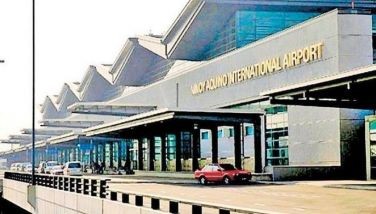Agri growth seen at 5.85% this yr
December 20, 2004 | 12:00am
Despite unfavorable weather, particularly in the fourth quarter, the agriculture sector is projected to grow in the range of 5.11 percent to 5.85 percent, exceeding the original projected growth rate of 4.8 percent to five percent for 2004, Agriculture Secretary Arthur Yap said over the weekend.
"Early indications show there is a great likelihood that the growth rate of five percent for the year will be achieved, net of the damages caused by the four typhoons in the last quarter which reduced output by two percentage points," said Yap, stressing the growth rate could even be higher, in the range of 5.11 to 5.85 percent.
Yap noted the consistent positive performance of the agriculture sector which comprises a fifth of the country’s total economic output and employs more than half of the country’s workforce.
It started off with a robust gain of 7.98 percent in the first quarter, 4.22 percent in the second quarter and 7.94 percent in the third quarter to post a cumulative growth of 6.8 percent from January to September this year.
"Even with the four typhoons, the annual growth rate target is still achievable because there was an early intervention done in rice and corn," noted Yap, referring to the DA’s push for the use of certified and hybrid seeds, proper use of fertilizers and loan assistance to increase production of the country’s main staples.
Yap said the main growth drivers in the sector are palay, corn and aquaculture. Palay and corn account for about 16 percent and six percent of total agricultural output. Aquaculture on the other hand, has substantially increased its share to total output to 12 percent this year.
The strong growth in the first nine months earlier raised hopes the agriculture sector could exceed this year’s growth target of 4.5 to five percent.
Agriculture experts said, however, that a lot depends on crucial interventions required to make growth sustainable.
One is the budget devoted to agriculture. The DA submitted a 2005 budget of P25 billion to the Department of Budget and Management, which revised it to P14.5 billion. The President’s budget is divided into the P4.3-billion regular budget of the DA and P10.3 billion for the Agriculture and Fisheries Modernization Act.
In 2003, the DA received a total budget of P16. 8 billion, and its re-enacted budget this year amounts to P13.6 billion. Broken down by agency, some P2.67 billion of the 2005 budget is allocated for the Office of the Secretary; P1.8 billion to fund local projects; P4.2 billion as counterpart funding to foreign-assisted projects; P974 million to the DA bureaus; P1.4 billion to its regional field units and P1.8 billion to DA attached agencies. Also included is subsidy to attached corporations amounting to P1.6 billion.
The DA’s 2004 budget is 26 percent lower than the proposed budget and lowest in real terms if one takes into account inflation but the re-enacted budget for 2005 would already be the lowest so far .
Morever, there is concern that the El Niño weather phenomenon, rising costs of imported inputs and the surge in fuel prices could dampen growth.
Yap said the DA is now implementing several mitigation measures to cushion the impact of the El Niño which is expected to hit production areas in the summer months. He stressed that the dry weather phenomenon, considered a mild one, will have little impact on palay production because the DA has recommended early planting of the crop by farmers, especially in irrigated areas.
"Early indications show there is a great likelihood that the growth rate of five percent for the year will be achieved, net of the damages caused by the four typhoons in the last quarter which reduced output by two percentage points," said Yap, stressing the growth rate could even be higher, in the range of 5.11 to 5.85 percent.
Yap noted the consistent positive performance of the agriculture sector which comprises a fifth of the country’s total economic output and employs more than half of the country’s workforce.
It started off with a robust gain of 7.98 percent in the first quarter, 4.22 percent in the second quarter and 7.94 percent in the third quarter to post a cumulative growth of 6.8 percent from January to September this year.
"Even with the four typhoons, the annual growth rate target is still achievable because there was an early intervention done in rice and corn," noted Yap, referring to the DA’s push for the use of certified and hybrid seeds, proper use of fertilizers and loan assistance to increase production of the country’s main staples.
Yap said the main growth drivers in the sector are palay, corn and aquaculture. Palay and corn account for about 16 percent and six percent of total agricultural output. Aquaculture on the other hand, has substantially increased its share to total output to 12 percent this year.
The strong growth in the first nine months earlier raised hopes the agriculture sector could exceed this year’s growth target of 4.5 to five percent.
Agriculture experts said, however, that a lot depends on crucial interventions required to make growth sustainable.
One is the budget devoted to agriculture. The DA submitted a 2005 budget of P25 billion to the Department of Budget and Management, which revised it to P14.5 billion. The President’s budget is divided into the P4.3-billion regular budget of the DA and P10.3 billion for the Agriculture and Fisheries Modernization Act.
In 2003, the DA received a total budget of P16. 8 billion, and its re-enacted budget this year amounts to P13.6 billion. Broken down by agency, some P2.67 billion of the 2005 budget is allocated for the Office of the Secretary; P1.8 billion to fund local projects; P4.2 billion as counterpart funding to foreign-assisted projects; P974 million to the DA bureaus; P1.4 billion to its regional field units and P1.8 billion to DA attached agencies. Also included is subsidy to attached corporations amounting to P1.6 billion.
The DA’s 2004 budget is 26 percent lower than the proposed budget and lowest in real terms if one takes into account inflation but the re-enacted budget for 2005 would already be the lowest so far .
Morever, there is concern that the El Niño weather phenomenon, rising costs of imported inputs and the surge in fuel prices could dampen growth.
Yap said the DA is now implementing several mitigation measures to cushion the impact of the El Niño which is expected to hit production areas in the summer months. He stressed that the dry weather phenomenon, considered a mild one, will have little impact on palay production because the DA has recommended early planting of the crop by farmers, especially in irrigated areas.
BrandSpace Articles
<
>
- Latest
- Trending
Trending
Latest




























